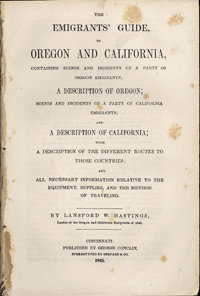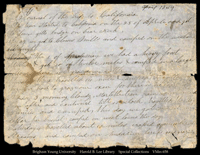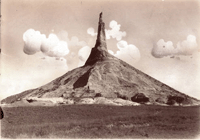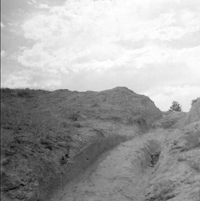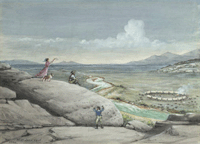

| In
the last day of our departure from Independence, we passed the
last human abode on our route: From the borders of Missouri
to those of New Mexico not even an Indian settlement greeted our eyes. — Josiah Gregg
By covered wagon and handcart the emigrants came west across the plains and mountains of America. What was it like to walk 2,000 miles for the promise of fertile ground, a chance for fortune, and the dream of a new life? Who were these individuals who risked the arduous trip? What were the living conditions along the trails from Missouri to California and Oregon? Insight into this six-month journey can be derived from newspaper accounts, contemporary books of the era, and personal diaries of the people who forged an expanding nation. Many organizations, commercial companies, and individuals are publishing these materials on the Web for easy electronic access. A TRAVEL GUIDE: Prairie Traveler Captain Randolph Barnes Marcy, a veteran soldier, wrote what one would consider today as the definitive guide for travel on the overland trails. He describes the advantages and disadvantages of the different routes to California and Oregon and gives practical advice on everything from daily itineraries to the treatment of rattlesnake bites experienced on the westward trails in the Prairie Traveler. TRAILS WEST. . . End of the Oregon Trail Interpretive Center The End of the Oregon Trail Interpretive Center brings history alive through reenactments, videos, and print material. Historical information about the role of black pioneers in the settlement of Oregon is very informative. Included are a timeline of events, political reactions, exclusion laws, and biographies. Another outstanding feature of this Web site is the series of articles written by Jim Thompson about the massive migration of settlers. Samples include "Outfitting for the Trail," "Life on the Trail," and "Hardships on the Oregon Trail." Here you'll find as well a diagram of a loaded wagon from the 1843-1860 era, the primary mode of transportation, often filled with over a ton of supplies, furniture, and other possessions. A complete diagram of a loaded wagon is provided along with a list of supplies and their cost. . The Overland Trail was the route established in 1862. It avoided the Indian uprisings that were occurring on the Oregon Trail farther north. This also became the main road for the Overland Stage Company. Brief descriptions of stations, stops, and landmarks are presented along with a host of links to pioneer stories, maps, and other relevant material. PERSONAL ACCOUNTS Women on the Trail At times life along the trail seemed quite ordinary. Walking 16 to 25 miles per day could be boring. Women cared for children and tended to the laundry and cooking duties while men drove the team of oxen, maneuvered across rivers, and repaired wagons. However, there were times of great suffering when cholera epidemics, illness, and accidents would take loved ones away. In the excerpt from Women's Diaries of the Westward Journey by Lillian Schlissel, one child reflects that those who suffered the most were the moms: Some of the women I saw on the road went though. a great deal of suffering and trial. I remember distinctly one girl in particular about my own age that died and was buried on the road. Her mother had a great deal of trouble and suffering. It strikes me as I think of it now the Mothers on the road had to undergo more trial and suffering than anybody else. — Martha Ann Morrison, age 13 Catherine Sager Pringle wrote her diary in 1860 about the journey from Missouri to Oregon. She originally emigrated from Ohio with her family to Missouri. She relates incidents on the trail, the poignant story of her father's and mother's deaths, and her days in Indian on the captivity in Across the Plains in 1844. Emily Towell wrote a fascinating day-by-day account of the daily occurrences of trail life, from the sad departure with loved ones to the excitement of a rabbit barbecue to the unexpected treat of mountain trout in the Diary of Emily Towell-1881. Narcissa and Marcus Whitman's efforts to set up a mission serving the Cayuse Indians at Waiilatpu in the Walla Walla Valley ended tragically in November 1847. Cultural misunderstandings and a series of unfortunate events leads to an attack on the Whitmans that result in their deaths. Narcissa Whitman's letters home offer vivid reports on frontier life (Letters and Journals of Narcissa Whitman 1836-1847). Men on the Trail Commerce was the driving force in blazing pathways to the West. Mountain men in search of fur supplied the fashion fancies of women in the East. The 1849 Gold Rush had men flocking to the mines to claim their fortunes. Greenhorns not used to the rigors of trail life had difficulty controlling their teams or knowing how to maintain their wagons. For others, life was a boring routine. William Todd writes home about the tribulations of ascending mountains by literally "throwing their wagons like handspikes." His reports were published in the Sangamo Journal, Springfield, Illinois (Advice William Todd-I846). First published in 1844, this two-volume book contains the travel stories of Josiah Gregg, a Santa Fe trader. Chapters cover the origin and development of the Santa Fe trade route, harnessing pack mules, and preparations for trips (Commerce of the Prairies — Josiah Gregg). When the Donner Party became hopelessly stranded in the mountains without adequate provisions, a few of them kept diaries of the ordeal. Some of the settlers resorted to eating the flesh of those who had died in order to stay alive in the brutal winter weather conditions. Patrick Breen provides a daily account of the weather and the health of the people (Patrick Breen's Diary-1846). DIETARY STAPLES, PASTIMES, AND LORE What provisions were available along the way? What kind of music
did the pioneers enjoy? What were their favorite pastimes? Randolph
Barnes Marcy, the Prairie Traveler, describes: Through a fictional but accurate account, you will come to understand the changes in the environment that have occurred since the pioneers traversed the territory over 100 years ago (Fish and Wildlife on the Oregon Trail: Then and Now). The Heritage Gateways site features historical diaries, excerpts from published books, articles, commentaries, maps, recipes from the trail and multimedia that reflect the life and times of early pioneers. Listen to the melodies of songs that the people sang around campfires, Build a handcart, and read trail stories written by children. One heart-rending song expresses in words the thoughts of many pioneers: Do they miss me at home? Do they miss me? Learn about the tragic events surrounding the ill fated Donner Party
using this Web-based lesson developed by Education First, Pacific
Bell Knowledge Network. Students assume the roles of historian, cartographer,
diarist, correspondent, jester, provisioner, or scientist and complete
a series of activities using a series of hyperlinked sites. A Hyperstudio
template for publishing student projects compliments the lesson and
can be downloaded from the site. Load those wagons. Kiss the kin good-bye, You've decided to embark
on an extraordinary adventure that will take you and your family
across miles of dangerous, unfamiliar territory. You've gathered
with other pioneers in Independence, Missouri. Everything that will
fit inside is packed into your prairie schooner. You are as ready
as you can be for the journey of nearly 2,000 miles. Join students
from across the country on this interactive online Oregon Trail simulation
project. The depth of instructional materials, resources, links,
and just plain fun is exceptional. |
||||
|
||||
UpdatedMarch 11, 2015 © 1996 - 2015 Linda C. Joseph All Rights Reserved All CyberBee Graphics are Trademarked Graphics by Darlene Vanasco/Creative Director Erika Taguchi/Designer & Illustrator Hosting Provided by Iwaynet |
||||
